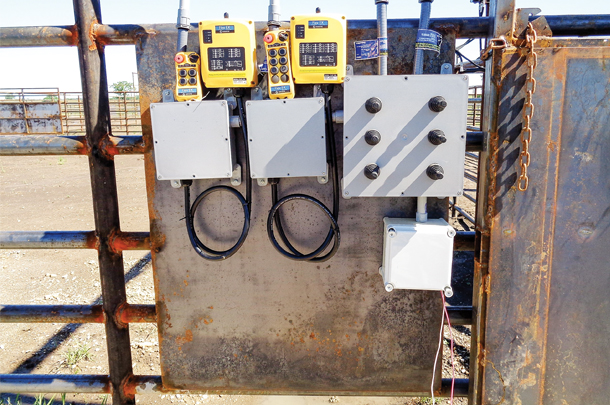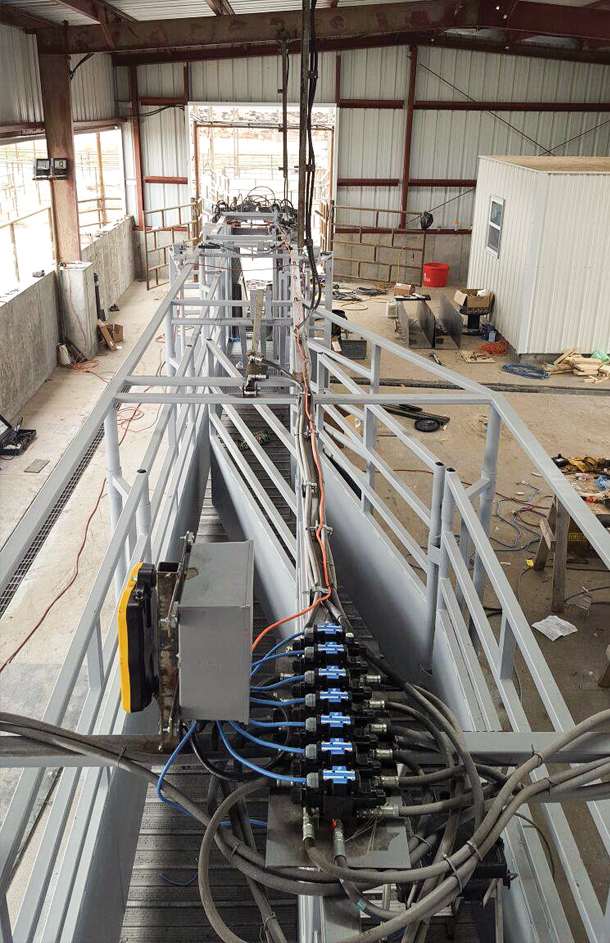Plus One Manufacturing, based in Valentine, Nebraska, has built a business on helping farmers, ranchers, feedlots and livestock auctions design and create custom cattle-working facilities for safer, more efficient and profitable operation.
“Our working facilities designs are based on using the animals’ natural instincts for low-stress handling as well as for operator safety,” says Mike Schubert, owner of Plus One Manufacturing.
Every ranch is laid out differently and with custom equipment, such as their adjustable two-in-one alleys and hydraulically operated gates, and a combination bud box/tub enables producers to work according to their specific needs using their existing facilities with greater efficiency, safer operations and reduced labor costs.
When considering building a custom working facility, Schubert makes the following recommendations.
“Consider how your cattle flow now and where they tend to balk. Is your current facility designed to where the animal believes it’s going where it wants to without force?”
He says the most overlooked considerations to cattle flow through a facility are lighting and side height to where cattle can see humans in their flight zone.
“You want your facility to have as much natural lighting as possible. Watch for anywhere in your facility where there may be shadows that cattle will balk at.
You want cattle to move naturally into the chute and make it comfortable to leave the chute, which may require rubber mats if your chute sets on a cement pad. In order to achieve that, they need to see another cow in front of them or daylight,” he says.
Drainage and having a way to keep the facility clean are also important considerations.
“It helps keep the flies and smell down and makes it a more friendly environment to work in,” he says.
He also recommended gates 2 feet wider than your alley so they can’t slide through and knock someone over and to put in as many staging gates as you can with safety latches.
“We built our first working system in 1994. At the time, I wasn’t too interested in animal welfare. We built what the customer told us to build, copycatting what everyone else had done, including some of the Temple Grandin designs,” says Schubert.
Their combination bud box/tub design came from working with a client, Dick Cherry, who had created his own design approximately 10 years ago.
“I thought he was nuts, but it really opened my eyes because it worked so efficiently,” he says.
“The bud box is effective for getting animals into the barn but not always efficient in getting them up the alley. It takes a very experienced operator to make it work properly, and 90 percent of it is operated from the inside of the pen with the cattle, where the majority of accidents happen.”
 Combining it with hydraulically operated swinging tub gates eliminates the need to have a person in the crowding pen with the cattle and uses the cattle’s natural instinct to go back when they’ve come to a dead end, driving the cattle from the tub into the alley without bottleneck stoppage.
Combining it with hydraulically operated swinging tub gates eliminates the need to have a person in the crowding pen with the cattle and uses the cattle’s natural instinct to go back when they’ve come to a dead end, driving the cattle from the tub into the alley without bottleneck stoppage.
“I have worked cattle my entire life, and I’ve never seen a working system that is more efficient or better for low-stress cattle handling,” says Kevin Unger of Lincoln County Feed Yard and former manager of Decatur County Feed Yard in Oberlin, Kansas.
Plus One Manufacturing’s custom-built working facilities also feature adjustable two-in-one alleys with several door configurations and side-height options, allowing the producer to use one system to work 2,000-pound bulls or 200-pound calves. Alleys can be made in any length to accommodate existing facilities.

“We try to keep the animals side by side for as long as possible in the two-in-one alley because it keeps them calmer.”
Schubert has also found that his clients are facing a “labor crunch” and need to still get the job done with fewer skilled people. This has led him to design hydraulic gate systems that can be operated by the push of a button to sort cattle off the chute and load them into the alley.
“With fewer people, there is less of a risk of human injury and less stress on the cattle. It also saves a lot of money in terms of paying salaries every year,” he says.
“We have worked hard to make our work more efficient to keep prices down. With each customized working system we build, we are continually improving upon the quietness of our systems, cattle visibility and handler usage,” says Schubert.
“My relationship with my customers is important to me. I want my clients to be long-lasting friends. I have always believed in giving the customer a little bit more than what they ask for, and it’s become important to me to find the most humane ways to work cattle,” he says.
While based in Valentine, Nebraska, Plus One Manufacturing has built working systems and facilities throughout the U.S. and Russia. ![]()
For more information and to see the other products they build, visit their website (Plus One Manufacturing).
Jennifer Archibald is a freelance writer from Lodgepole, South Dakota.
PHOTO 1: Mike Schubert welding a gate.
PHOTO 2: A hydraulic system with hand-held remotes.
PHOTO 3: A Plus One Manufacturing two-in-one alleyway with hydraulic gate system. Photos by Jennifer Archibald.








